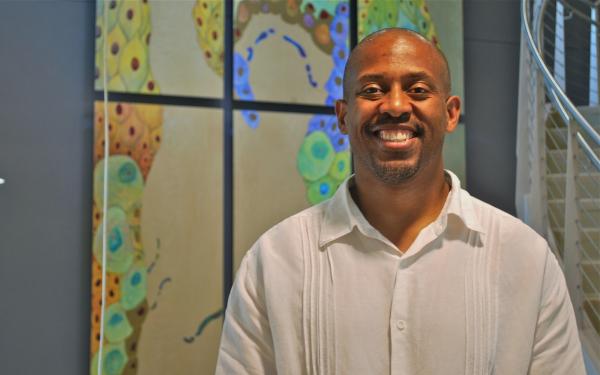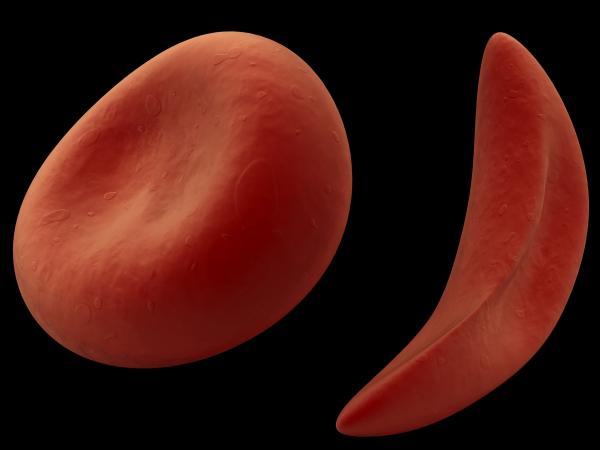Ed Botchwey's research takes sharp turn as they explore possible new causes for the disease.
Ed Botchwey is not a hematologist. He’s very clear about that. Botchwey runs a tissue-engineering lab at the Parker H. Petit Institute for Bioengineering and Bioscience, with a focus on regenerative medicine.
That’s been his professional history – tissue engineering and regenerative medicine. But there’s a piece of personal history that carries a bit more influence, and that, perhaps more than anything else, is what led Botchwey and his research team to publish in the journal Blood, the most cited peer-reviewed publication in the field of hematology.
Their research and paper, with the running title, “Sphingolipid Metabolism in Sickle Cell Disease,” represents a sharp turn for Botchwey and his colleagues, who shed new light on causes for some of the disease’s pervasive and devastating symptoms, while offering new hope for patients who struggle with the disease, people like his sister.
“As it turns out, my sister has sickle cell disease, and I have a student, the first author of this paper, Anthony Awojoodu – his sister has it. So this is something we felt very passionate about,” says Botchwey, associate professor in the Wallace H. Coulter Department of Biomedical Engineering (Coulter Department), who didn’t set out to research sickle cell disease (SCD). It just sort of happened. He was just following a logical trail of research.
“We’d been looking at certain classes of signaling lipids and how they regulate inflammation. Part of our goal was, and still is, exploiting certain inflammatory responses to help in tissue regeneration,” Botchwey says. “But along the way, we recognized that some of the enzymes that are central components in the metabolism and production of these signaling lipids were responsive to stresses in cell membranes.”
Like, for example, the stresses that cause the telltale geometric distortion of red blood cell (RBC) membranes in sickle cell disease (SCD). It occurred to Botchwey that SCD would make a great model system in which to observe the relationship between membrane stresses, inflammation and the metabolism of these sphingolipids. Turns out, there’s a very close relationship.
Their findings reveal for the first time that sphingolipid metabolism is indeed dysregulated, or altered in SCD. Membrane stresses associated with SCD activate sphingomyelinase (SMase), an enzyme that contributes to progression of the disease (SMase has been implicated in vascular inflammation). SMase, in concert with other enzymes, also causes elevated production of microparticles, which contribute to what Botchwey calls, “this chronic inflammatory state that underlies so much of the pathology of sickle cell disease.”
What encourages Botchwey is the research also illuminates potential new strategies to regulate inflammation through modulating sphingolipid metabolism – results that may also be applicable to other red blood cell disorders, not just SCD. What’s more, a promising therapeutic solution is already close at hand – the antidepressant, amitriptyline.
“We wanted to know, can you pharmacologically inhibit SMase in order to reduce these pro-inflammatory microparticles. And we found that, in fact, we can, and we’re excited about it. If you can cut off one of the primary means whereby sickled red blood cells are perpetuating a chronic inflammatory state in the patient, then you may be cutting off a wide range of the disease consequences associated with SCD,” says Botchwey. “Amytriptyline happened to factor quite highly in our survey of potential inhibitors of SMase. You can find certain papers that will make an indirect association to what we’ve shown.”
Sure enough, there are 30-plus year-old research papers that explore the inhibitive effects of tricyclic antidepressants on SMase in various contexts, and Botchwey’s team connected the complicated dots. But there has been next to no research on the role of SMase and sphingolipid dysregulation in SCD (a disease that affects millions worldwide), and that surprises Botchwey.
“It’s a mystery to me.” says Botchwey. “When you think about a disease as prevalent as this one, as well understood as it is, in terms of what the underlying genetic mutation is, and you consider all the tools we have at our disposal for correcting such mutations, you would think this would be a curable disease. I’ve lamented the fact that it’s not cured, but never considered that I might be part of the research that might lead to a cure.”
Botchwey, whose work is supported by the NIH and NSF, as well as the Petit Institute and Coulter Department, led a research team that included Awojoodu, a native Nigerian who was responsible for recruiting Petit Scholar, Alicia Lane, to the team.
“They struck up a very productive working and mentoring relationship, and this paper is partly the culmination of that,” says Botchwey, whose collaborators in the study also include Phillip Keegan, Yuying Zhang, Kevin Lynch from the University of Virginia, and BME assistant professor Manu Platt.
Botchwey, not a blood guy, says this research represents a new direction for him, one he might not have taken if he didn’t make the move several years ago from the University of Virginia to the Georgia Institute of Technology, and the Petit Institute.
“Like I said, I’m not a hematology researcher, but the opportunity to take risks resonated with me. It’s a risk to go in new directions, and Georgia Tech enabled me to take that risk,” he says. “The multidisciplinary, interdisciplinary environment here is one in which I felt comfortable asking what I perceived to be a frontier question that impacted a disease I felt passionately about. I don’t know if that would have happened if I’d stayed where I was.”
This study was supported in part by NIH Grants 1R01DE019935-01, 1R01AR056445-01A2 and R01GM067958, and 1DP2OD007433-01 and NSF Grant NSF#0933643.
Media Contact
Jerry Grillo
Communications Officer II
Parker H. Petit Institute for
Bioengineering & Bioscience
Keywords
Latest BME News
Jo honored for his impact on science and mentorship
The department rises to the top in biomedical engineering programs for undergraduate education.
Commercialization program in Coulter BME announces project teams who will receive support to get their research to market.
Courses in the Wallace H. Coulter Department of Biomedical Engineering are being reformatted to incorporate AI and machine learning so students are prepared for a data-driven biotech sector.
Influenced by her mother's journey in engineering, Sriya Surapaneni hopes to inspire other young women in the field.
Coulter BME Professor Earns Tenure, Eyes Future of Innovation in Health and Medicine
The grant will fund the development of cutting-edge technology that could detect colorectal cancer through a simple breath test
The surgical support device landed Coulter BME its 4th consecutive win for the College of Engineering competition.









